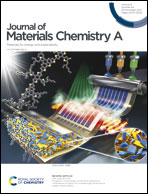Multiple charge separation pathways in new-generation non-fullerene acceptors: a computational study†
Abstract
Non-fullerene acceptors led to outstanding improvements in the efficiency of organic photovoltaic devices, with high promises of further advancements. Several studies have been performed to rationalise their exceptional performances, with the final goal of developing a reliable protocol for the identification of new materials with better properties. In this respect, we here combine molecular dynamics, density functional theory and Fermi's Golden Rule (FGR) to model two recent all-small-molecule bulk heterojunctions with high power conversion efficiencies, namely ZR1:IDIC-4Cl and ZR1:Y6 (Nat. Commun. 2019, 10, 5393). We evaluate the FGR rates for photoinduced hole and electron transfer, excitation energy transfer, and charge recombination on a statistical ensemble of donor/acceptor pairs extracted from molecular dynamics simulations. Our results provide a simple rationalisation of the great performance of Y6: aside from a slower charge recombination rate, we found that the charge transfer state for ZR1:Y6 can be accessed both via electron and hole transfer, while the latter pathway is significantly slower for IDIC-4Cl, indicating that its first excited state behaves as a trap, as confirmed by a simple kinetic model. In light of the recently reported possibility of developing donors and acceptors with complementary absorption spectra, multiple photoexcited charge transfer pathways represent a key property to efficiently harvest the whole solar spectrum.



 Please wait while we load your content...
Please wait while we load your content...